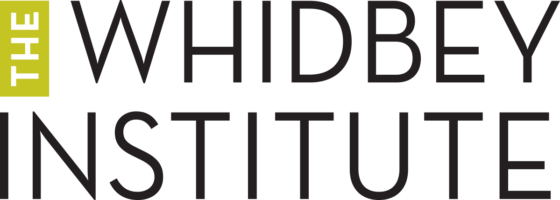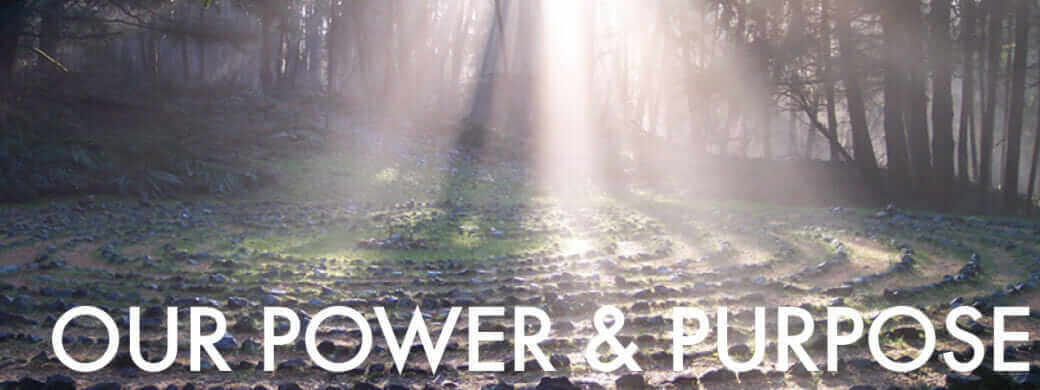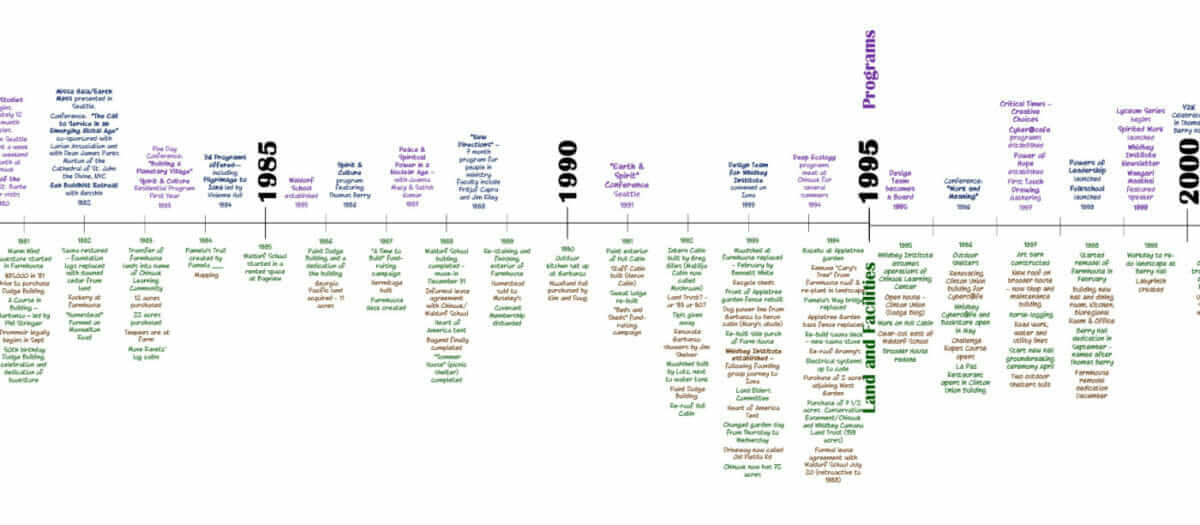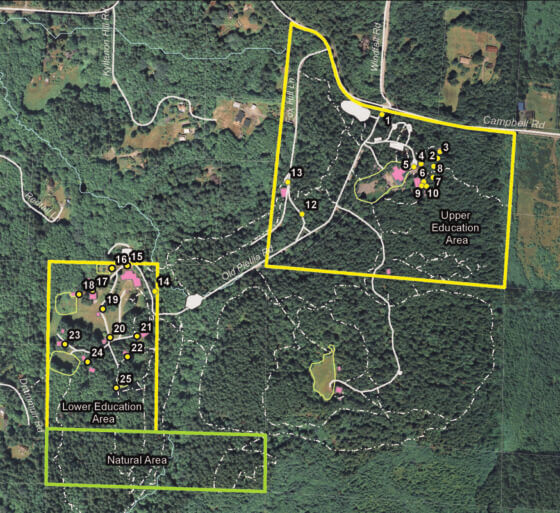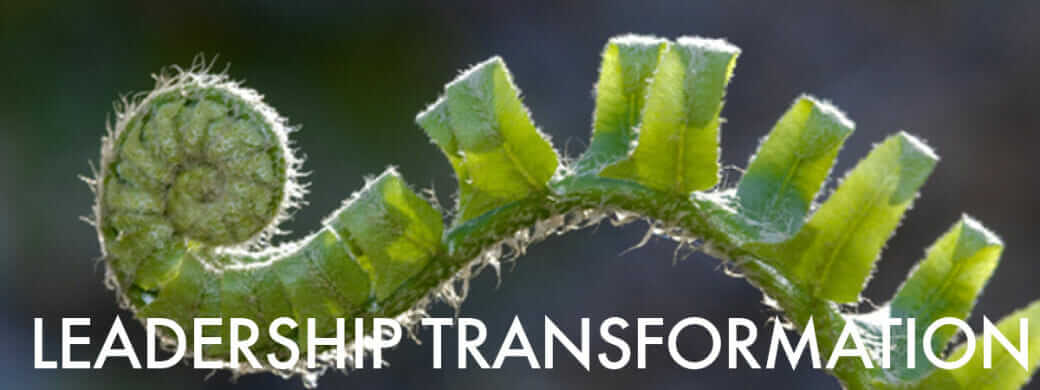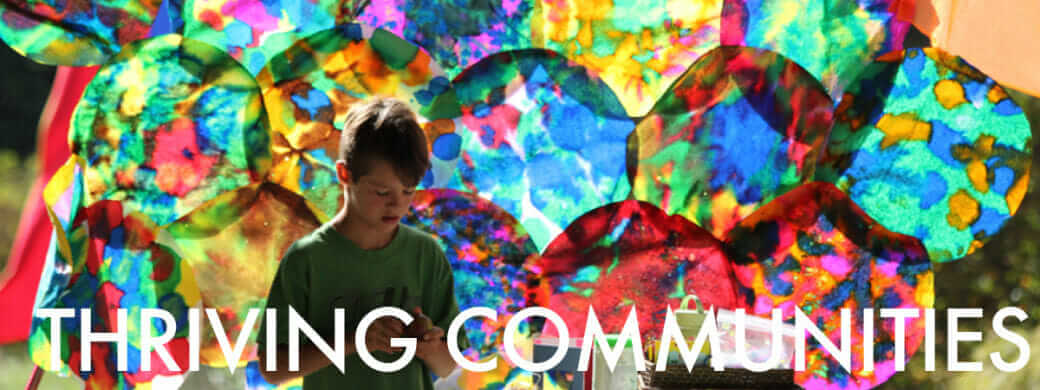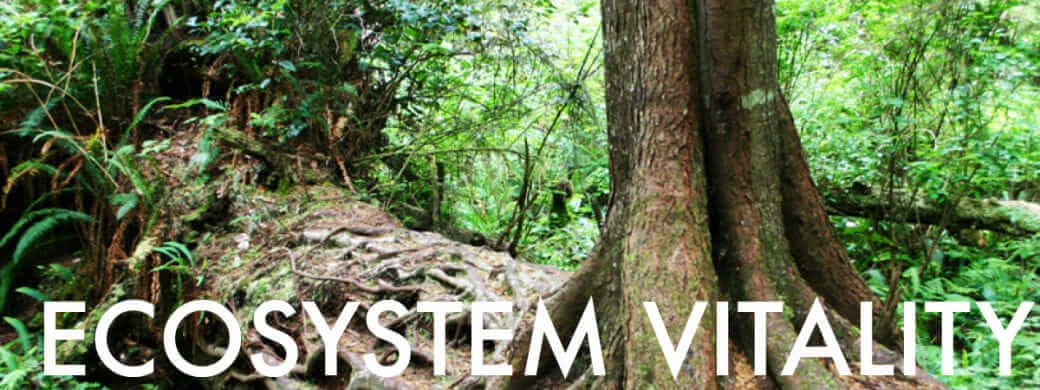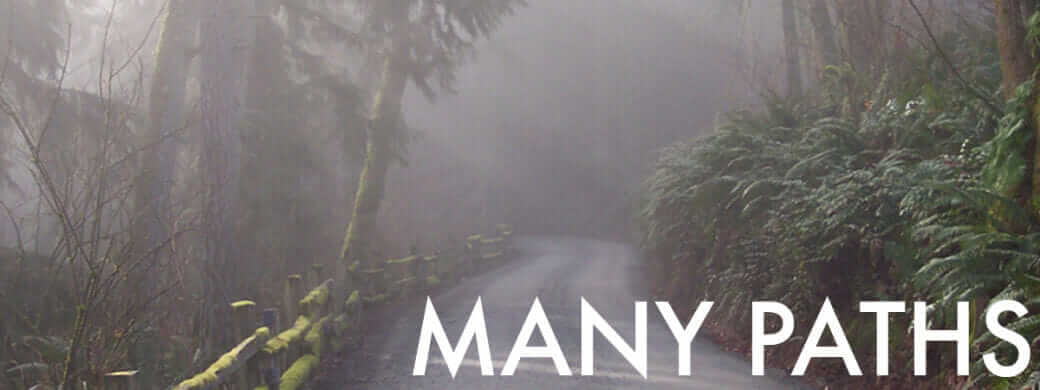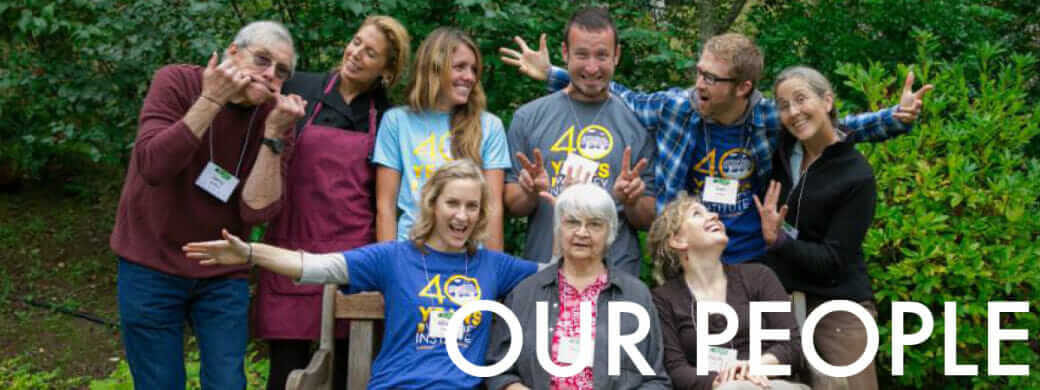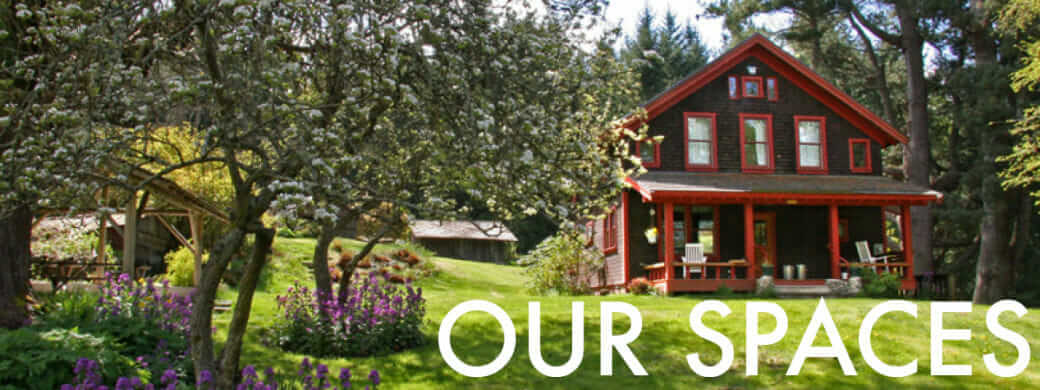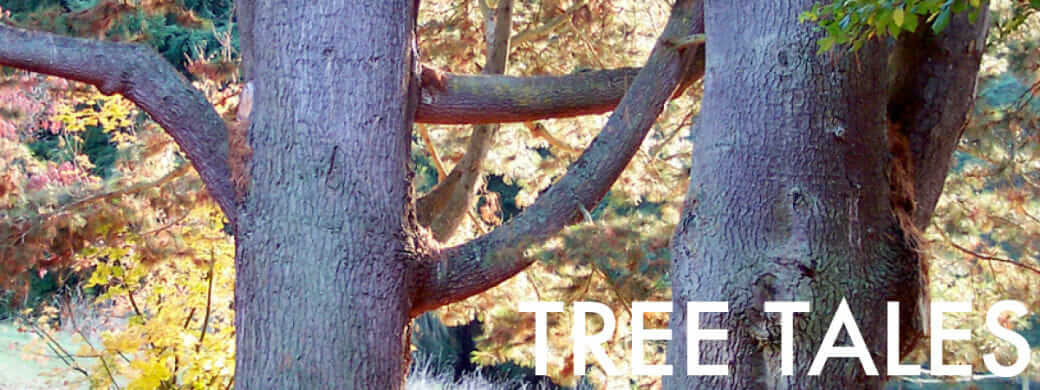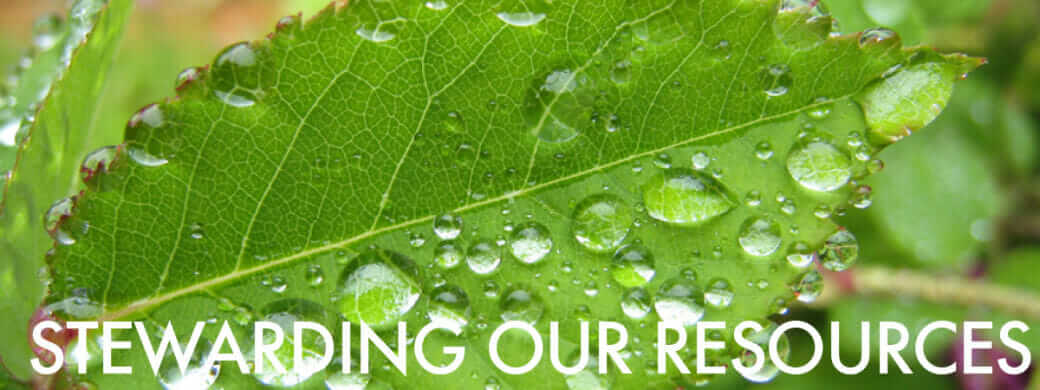This online report is part of our commitment to steward our resources with care. Plus, we get to share more, in more ways. Thank you for joining us here on the web, and for all you do to make these stories come alive. We hope you enjoy!
When Fritz and Vivienne Hull came to this historic Finnish farm in the Maxwelton Valley in 1966, they hungered for community, reflection, and a connection to nature in a place that felt like home. Their work, for Earth, Spirit, and the Human Future, took the form of the Chinook Learning Community in 1972.
Out of this community grew the Whidbey Institute, which now serves the entire Cascadian Bioregion from our home at Chinook. Here, in the embrace of our 100 acre heritage forest, we engage with the most serious issues of our time with a foundation of optimism, a spirit of joy, and a confidence in our collective work to build a more vibrant, just and peaceful world.
. . . . . . . . . . . . . . . . . . . . . . . . . . . . . . . . . . . . . . . . . . . . . . . . . . .
COMMITMENT TO THE THE GREAT WORK
OVER THE LONG HAUL
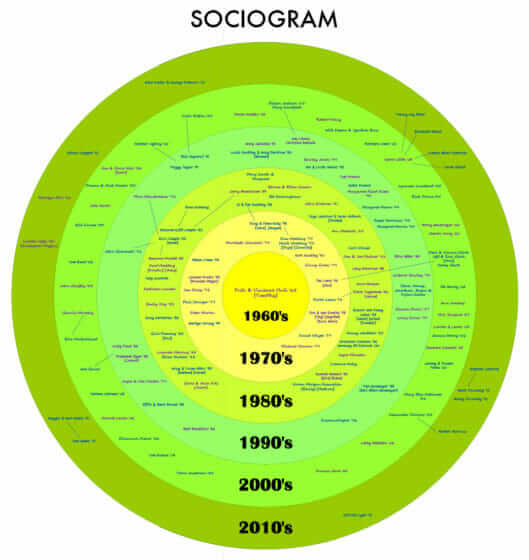
In 2013, we celebrated our 40th Anniversary with a September Festival. The work that took place leading up to, during, and following the Festival represented all that we value about our heritage and home: uncommon work for the common good. The transformative and inspiring stories we shared during that momentous weekend serve to fuel our ongoing work. Highlights of the Festival included a powerful celebration of Fritz and Vivenne’s work and three compelling keynote presentations. View photos from the event here.
We were inspired by Joanna Macy to think in terms of Deep Time: to invoke those that have come before and those that are to come, drawing on the wisdom of all Earth’s life—from all time—in this place, at this moment.
David Spangler then spoke on the Importance of This Place and the long range view of time: the seeds of war are bearing fruit today, he said, but the seeds of peace have already been sown. Many of us came away with the hope that a new harvest is coming.
Finally, we enjoyed Drew Dellinger’s address on Moving Foward in the Spirit of Thomas Berry. Fueled by Drew’s eloquence and hope, we convened after lunch for a festive procession, and the weekend ended with a beautiful Honoring of Place, Spirit, and Community.
Other Festival highlights included the Ignite talks, a powerful collection of five-minute presentations on the work of the Whidbey Institute and other organizations, inspiring all to engage more fully in direct service to our hearts’ work.
The sociogram (pictured above) was one of several tools we shared at the Festival to better understand ourselves and our community. Developed by Institute Fellow, Sharon Parks, it charts people and organizations who moved to Whidbey Island as a result of their connection to Chinook. Of those we were able to contact, over 120 people registered. They are seen graphed by the year they moved. The timeline, (pictured below) is another interesting body of research and reflection. It shows land, facility, and programmatic milestones from the Hulls’ arrival in the 60s to our work in the current decade.
We owe a deep debt of gratitude to the many volunteers, board members, fellows, partners, sponsors, and staff members who supported with a range of activities leading up to and on the day of the celebration. Together, we created a weekend program worthy of four decades’ inspiring work. We extend a special thanks to Kate Snider for her year-long care in leading this impassioned team.
. . . . . . . . . . . . . . . . . . . . . . . . . . . . . . . . . . . . . . . . . . . . . . . . . . .
FOUNDERS’ ENGAGEMENT
Fritz and Vivienne Hull still play a vital role in the Institute community as keepers of the ~30 acre Spirit of Legacy Forest. Legacy Forest is home to programs like PYE Global Social Artist Gatherings and Power of Hope Youth Empowerment Camps, and is often the stomping ground for neighboring Waldorf explorers. The StoryHouse was utilized throughout the year for Board Retreats and as a youth center during large conferences.
Additionally, the Hull Family worked closely with the Institute’s skilled Site Committee and trusted advisers to address boundaries of the Chinook Lands that were not adjoined. Here are details of that process:
A Statement for Mutual Release Agreed Upon by the Hull Family and the Whidbey Institute Regarding Boundary Line Adjustment Within the Chinook Lands
We are happy to share that we have completed a very creative process that has led to a boundary line adjustment that is mutually beneficial to both the Whidbey Insitute and neighboring property owners, the Hull family. If you look carefully at a real estate map of the Whidbey Institute’s land, you realize that it is composed of two large parcels that are not actually connected. The place where the two pieces don’t meet each other is in the area of the lower parking lot including a portion of the road into the Institute. Since the early years of the formation of the Chinook Learning Center, the predecessor to the Whidbey Institute, the Hull family has owned land next-door that over time ended up lodged in between the two parcels that were acquired by Chinook and now owned by the Whidbey Institute. For many years everyone involved has known that we should someday invest the time and energy to find a way that all the Institute’s land is contiguous.
As a result of this adjustment the Hulls will now own some of land that runs along a hill top above the lower parking lot, and the Institute will now own a lower area that includes the lower parking lot and the road into the Institute. The Hull family will donate two-and-a-half acres to the Whidbey Institute that will finally join together the two large pieces of the Institute’s land.
We are all grateful for the results of this work and for the good spirit in which it was accomplished. We are more aware than ever of the great responsibility we all bear to be wise stewards of this land, to use all of it well for the Institute’s mission, and to make it available to the broader public to experience the power and beauty of this land.
The image above, produced by the Whidbey Camano Land Trust before the boundary line adjustment, shows conservation areas outlined and numbered GPS locations.
. . . . . . . . . . . . . . . . . . . . . . . . . . . . . . . . . . . . . . . . . . . . . . . . . . .
LOOKING FORWARD
As the 40th Festival was drawing to a close, with Drew Dellinger speaking Thomas Berry’s words—“the universe is not a collection of objects, it is a communion of subjects”—an awareness was growing that this is now the time to evolve beyond operating as a ‘retreat center with a purpose,’ into an active and vital institute.
Associate Director Heather Johnson, Intern Kathleen Hosfeld, and an extraordinary volunteer task force have engaged the exploration of ‘Whidbey Institute as Institute.’ Vital questions have guided the way: What does right relationship—with self, with community, and with the ecosystem—look like? How do we cultivate a sense of belonging? How does the Whidbey Institute, itself, operate from principles of right relationship?
Kathleen, interning with the Institute through her Master of Arts in Transforming Spirituality at Seattle University, brings a unique combination of talents and gifts, including her professional capacities of Strategy Process Design and her uncanny ability to untie knots. Through a process tailored to our specific needs, the work is compelling and moving swiftly. The outcomes will be shared in the coming months, and you are all invited into the implementation process.
You have a role here, and we so look forward to your participation. May we shift our understanding of the Whidbey Institute, through all of this, from an object that we visit to a living system that holds and enhances our shared commitment to a world that lives in right relationship with life; a living system that connects us in a network of relationship with others who share our deep commitment. As stewards of this living system, may each of our own lives be deeply enhanced, and our sense of deep purpose engaged.
It is possible that what you are seeing as the most important thing to be done in the world is the most important. To be done by you. The leadership initiative of the Whidbey Institute is a collection of a broad range of work with partners who have found a home for their work here, with a shared principle of being the change we wish to see in the world.
Strength emerges from aligning our inner and outer worlds – with our spirit, our vocation, our communities and with life itself. Cultivating our individual and collective capacity to live from this place is the core purpose of our leadership transformation work. In 2013, we deepened our ties with mission-aligned partners. Together, we work in service of the common good.
. . . . . . . . . . . . . . . . . . . . . . . . . . . . . . . . . . . . . . . . . . . . . . . . . . .
CASCADIA CLIMATE COLLABORATIVE
In April 2013, the Whidbey Institute invited sixty climate leaders from around the Puget Sound region to a seed conference to invite this deepening conversation and encourage emergent networks and strategies. KC Golden, Policy Director at Climate Solutions, gave a compelling keynote, and a range of individuals offered inspiring “flash talks” on such topics as dealing with denial, re-framing the global warming meme, taking effective direct action, addressing despair, and cultivating personal resilience. The result was extremely promising. Participants found the day practical and grounded, provocative and inspiring. Overwhelmingly, they urged us to offer it again for a longer period to take the conversation deeper still.
From this seed grew the Cascadia Climate Collaborative, a program of the Whidbey Institute. Key collaborators include Kurt Hoelting, Larry Daloz, and Derek Hoshiko, as well as climate activists, planners, business leaders, and grassroots organizers who are committed to this effort. The Whidbey Institute is emerging as a home for this work – as a place to come together for reflection, conversation and deepening collaboration.
. . . . . . . . . . . . . . . . . . . . . . . . . . . . . . . . . . . . . . . . . . . . . . . . . . .
PYE GLOBAL & POWER OF HOPE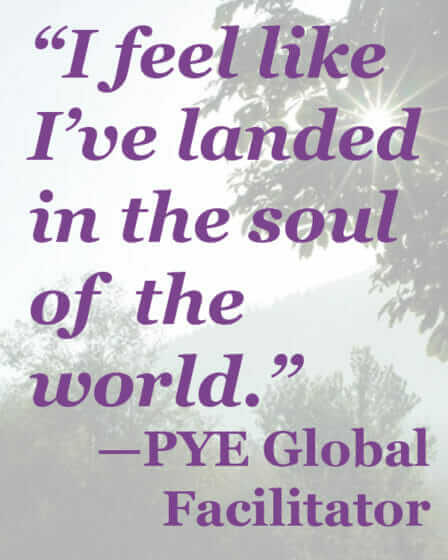
PYE stands for Partners for Youth Empowerment. PYE Global camps are based on the Creative Community Model and are effective in helping young people to feel safe and supported while also motivating them to reach out and become active members of their community.
Last June, 95 facilitators from around the world gathered at the Whidbey Institute for the PYE Global Social Artist Gathering. The five days of shared learning and creative expression deepened connections and strengthened PYE’s impact in the world.
Immediately following the camp, PYE held a Power of Hope arts-based empowerment camp for 45 teens on the 30 acres surrounding Storyhouse. The young people worked with 30 adults, including teaching artists from Uganda, India, and Brazil. One youth from Brazil said that the best thing about the camp was “the respect and understanding from everyone.”
Read more about their impact here.
. . . . . . . . . . . . . . . . . . . . . . . . . . . . . . . . . . . . . . . . . . . . . . . . . . .
HEART OF CONSULTING: A MODEL PARTNERSHIP
In 1965, Geoff Bellman‘s father Bill Bellman showed a piece of real estate to a young couple looking for adventure. The rest, as they say, is history: the couple was our very own Fritz and Vivienne Hull, the land became what we now know as Chinook, and the real estate agent’s son grew to be one of the Whidbey Institute’s most loyal friends and supporters.
Geoff also grew to be a respected author and consultant, and has spent much of his career helping organizations of all sizes become better in mission focus and performance. We’ve benefitted from his wisdom, his deep listening, and his ability to gracefully challenge assumptions. He is a key member of our strategy team, and a model partner.
Although Geoff says he’s retired, one wouldn’t know it by observation: he continues to support the work of myriad organizations in many ways. His Heart of Consulting workshop, held at the Whidbey Institute in October 2013, served as a dual fundraiser for BGI/OSR and the Whidbey Institute. This partnership is a model for how we can live with symbiotic practices as members of a Thriving Community.
. . . . . . . . . . . . . . . . . . . . . . . . . . . . . . . . . . . . . . . . . . . . . . . . . . .
BIONEERS
Inspiring a shift to live on Earth in ways that honor the web of life, each other, and future generations, Whidbey Island Bioneers Conferences bring this work to the Puget Sound, convening individuals across generations, disciplines, and backgrounds for one shared purpose: to live in a way that honors life.
As a prelude to our 2013 Whidbey Island Bioneers Conference, the Whidbey Institute sent team members Dan Mahle and Allison Tongate to San Rafael, California for the 24th Annual National Bioneers Conference. This enabled our team to handpick the best content to present at our Whidbey Bioneers Conference, deepen our relationships with those involved in this work, and provide opportunities for our staff to grow and serve their own highest purposes. They found the conference, expansive, stunning, and powerful.
Due in part to Allison’s and Dan’s time in San Rafael, we are pleased to announce that the co-founder of Bioneers, Kenny Ausabel, will be joining us at the Whidbey Institute for our 5th Annual Bioneers Conference! Stay tuned for more details.
Inspired and energized, Dan and Allison returned to the Institute last Fall and began preparations for the regional gathering. In 2013, Bioneers Central recorded and released videos of the plenary talks to network communities across the nation. In addition to showcasing these powerful presentations, we hosted workshops from a diverse set of educators, activists, entrepreneurs, and community members to explore local applications of these essential, life-affirming values. See photos from the event here.
For a sense of the impact this gathering catalyzed check out this video: Addison didn’t know quite what to expect when he signed up to attend the Whidbey Island Bioneers Conference. What he discovered was a clearer sense of personal power and purpose in the world. This impulse led him to transform his life in the pursuit of a larger vision for himself and his offering to the world.
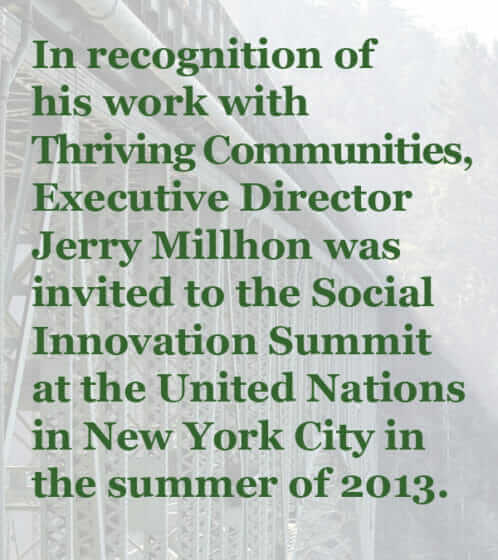 The Thriving Communities Initiative of the Whidbey Institute is fundamentally relational in nature and is the bedrock of all of our activity. It is a verb—an action and a culture we create inside and out. It is through this lens that all our work has meaning, trust and hope.
The Thriving Communities Initiative of the Whidbey Institute is fundamentally relational in nature and is the bedrock of all of our activity. It is a verb—an action and a culture we create inside and out. It is through this lens that all our work has meaning, trust and hope.
Through our Thriving Communities Initiative, we connect and support informal leaders across and within communities through community gatherings, video storytelling, conferences, and projects. We look at communities and thriving through a different lens each year, and have found in each that communities who are in varying stages of thriving have similar themes in place: dignity, respect, a sense of belonging, and trust. In 2012, our focus was Food Systems. You’ll read about our work in 2013 with Local Economies below.
We also strive to nurture our neighbors and our connections in our day-to-day work. From fresh garden produce for staff, volunteers, and the community food bank to free meditation and movement sessions in our Sanctuary, we work in service of life, health, and vitality. In 2013, we were blessed to have Peter Yanz and Sommer Albertsen bringing the gift of 5 Rhythms and Nia Dance to our conferences and festivals.
. . . . . . . . . . . . . . . . . . . . . . . . . . . . . . . . . . . . . . . . . . . . . . . . . . .
LIVING LOCAL ECONOMY
Our 2013 Thriving Communities Conference focused on Living Local Economy. community through the lens of Living Local Economy. The conference featured replicable case studies from Bellingham, Portland, Port Townsend, and South Whidbey Island, in addition to wisdom gathered from 20+ communities.
Whidbey Island Local Lending (WILL) is a shining example of strength in sharing. This new organization, which coalesced in 2012 and is inspired by the work of Port Townsend’s LION (Local Investing Opportunities Network) and catalyzed by the 1st Thriving Communities Conference. Our first conference planted the seed; our second watered it. This year, we’re delighted to see a flourish of sustained growth. At the end of 2013, WILL members had invested close to $300,000 in local businesses. This is a powerful example of trust in the midst of the challenges we call face today.
. . . . . . . . . . . . . . . . . . . . . . . . . . . . . . . . . . . . . . . . . . . . . . . . . . .
TCI INTERNS & ADVISORS
Our Thriving Communities Initiative was nurtured by the energy, care, and talent of two Interns in 2013.
Kattee Bierce joined us as a local Whidbey Island philanthropist and recent graduate from the Organization Systems Renewal Program at the Bainbridge Graduate Institute. She dedicated her time and expertise in program design and planning from June through to our Spring 2014 Conference. Her hospitality, good cheer, attention to detail, and passion for the content bolstered our design and outreach endeavors.
Nydia Blood joined us as a Master’s in Divinity student at Seattle University. Nydia brought her experience holding space for the spiritual within the secular, conversation and healing between the Spirit and the body, as well as attention to detail, inspiration, and power of storytelling. She was with us us from June to December, 2013.
Other key advisors to whom we extend gratitude include: Aimie Vallat, Lynn Willeford, Jeff Vander Clute, Dr. Hanmin Liu, Stephen Schwartz and Dr. Tim Popanz.
. . . . . . . . . . . . . . . . . . . . . . . . . . . . . . . . . . . . . . . . . . . . . . . . . . .
WALDORF STUDENT ENGAGEMENT
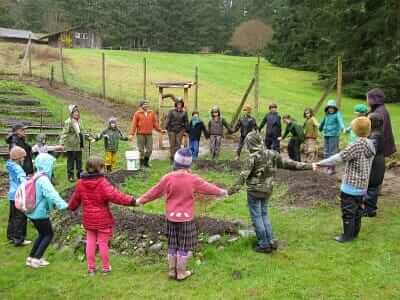 The Whidbey Institute and Chinook Lands are a place of celebration and ceremony, learning and exploration for our friends at the Whidbey Island Waldorf School.
The Whidbey Institute and Chinook Lands are a place of celebration and ceremony, learning and exploration for our friends at the Whidbey Island Waldorf School.
With mother nature as their classroom, Third and Fourth graders launched the 2013 garden season on Martin Luther King Day, turning over cover crops and raking leaves for mulch. We continued to enjoy their company throughout each season; they saw 2013 all the way through, and brought joy and vitality to service learning! In December, we harvested seeds and plants to create natural plant dyes, wove our dyed yarn on our garden loom, wrote spring 2014 garden wishes, and stuffed seed envelopes together in preparation for another season of bounty.
The children found wonder on the trails with Larry “Moss Man” Daloz and other guided expeditions. Their largest gathering is their annual Potlatch event where Waldorf families from all over the region come together for several days of cultural activities. Potlatch is an enriching time for parents, students and staff alike.
The Halls of Thomas Berry were also brought to life throughout the year with various class plays, graduations and eurythmy practice each Tuesday. We appreciate the many ways in which these young neighbors enrich Chinook with their energy and laughter. Thank you, students and parents, for joining us!
Our stewardship of the Chinook lands and gardens is a daily practice in ecosystem vitality, and programs which foster a deep respect for the natural environment are central to our work.
. . . . . . . . . . . . . . . . . . . . . . . . . . . . . . . . . . . . . . . . . . . . . . . . . . .
OUR FLOURISHING WESTGARDEN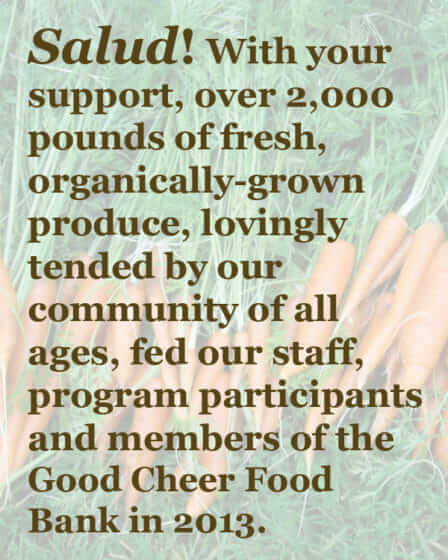
Our Land Care Coordinator, Community Garden Intern, and dedicated volunteers grew 730 pounds of produce for the Good Cheer Food Bank, 920 pounds for Christyn, our chef, and 420 pounds for staff and volunteers in 2013! This would not have been possible without the dedication of many! Thursday Workdays ran in the Westgarden throughout the growing season, bringing a community of friends together weekly for gardening, camaraderie, and a potluck lunch. To those who joined us, thanks—your gifts of time, energy, talent and friendship are treasured.
. . . . . . . . . . . . . . . . . . . . . . . . . . . . . . . . . . . . . . . . . . . . . . . . . . .
COMMUNITY GARDEN LEADERSHIP TRAINING
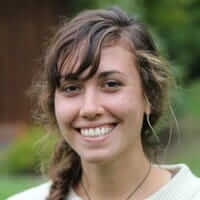
Alexa MacAulay with us as our Garden Intern. She became an invaluable member of our team during her stay here, as much for her warmth and creativity as for her farming skill, passion, and knowledge.
2013 was an incredible year of growth, friendship, abundance, and learning. In addition to Alexa, who lived and worked at Chinook, we had the pleasure of working with Camille Green, who was based in the Good Cheer Garden. Lissa Firor, whose focus was on the Good Cheer Food Bank worked with food preservation and held classes on preparation. You can still find Camille and Lissa at Good Cheer – both were offered staff positions following their internships! Casey Jackson inspired the next generation of gardeners at the South Whidbey Academy and South Whidbey Middle & Elementary School gardens, and held regular yoga gatherings in the Sanctuary as a gift to the community.
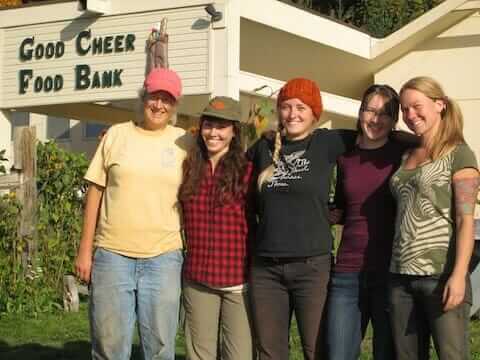 This program was funded in part by the Fresh Food on the Table Auction. Fresh Food on the Table is a program of the Good Cheer Food Bank, in partnership with Whidbey Institute and the South Whidbey School District and in collaboration with the South Whidbey Commons, Deep Harvest Farm, Greenbank Farm, and Skyroot Farm. In the spring of 2013, Thomas Berry Hall was filled with the shouts of a fast paced auctioneer and gleeful supporters. You raised your paddles for everything from hori-horis to a custom, high-end composter . . . all over great food and laughs with friends. The income generated by this event was shared among the partner organizations, and—with the addition of other funding—we were able to provide small stipends and/or work trades for Alexa, Camille, Lissa and Casey. Cary Peterson serves as a stalwart community coordinator and educator in this program.
This program was funded in part by the Fresh Food on the Table Auction. Fresh Food on the Table is a program of the Good Cheer Food Bank, in partnership with Whidbey Institute and the South Whidbey School District and in collaboration with the South Whidbey Commons, Deep Harvest Farm, Greenbank Farm, and Skyroot Farm. In the spring of 2013, Thomas Berry Hall was filled with the shouts of a fast paced auctioneer and gleeful supporters. You raised your paddles for everything from hori-horis to a custom, high-end composter . . . all over great food and laughs with friends. The income generated by this event was shared among the partner organizations, and—with the addition of other funding—we were able to provide small stipends and/or work trades for Alexa, Camille, Lissa and Casey. Cary Peterson serves as a stalwart community coordinator and educator in this program.
The value this passionate and skilled group of people brought to our community in 2013 is incredible. Rain or shine, these young women worked hard to bring you fresh, nutritious, and delicious produce. This program, and the networks of people and organizations within, beautifully embody our principles around intergenerational collaboration and service learning, community engagement, leadership development, and ecosystem vitality.
Pictured, from left to right: Cary Peterson, Alexa MacAulay, Camille Green, Lissa Firor, Casey Jackson.
. . . . . . . . . . . . . . . . . . . . . . . . . . . . . . . . . . . . . . . . . . . . . . . . . . .
SERVICE LEARNING WITH LEAF
It is always a great pleasure when the LEAF Service Learning Program of Edmonds Community College comes to the Westgarden! The LEAF School partners with tribes, government agencies, non-profits, and businesses to engage students through service-learning and community-based research in the hands-on application of traditional environmental knowledge to modern problems. At the core of the program is a
series of courses in human ecology and archaeology. Typical projects include traditional food revitalization, habitat restoration, ethnobotany, road ecology, and culturally modified tree surveys.
They joined us in March, to study sustainability and fertility cycles in the garden; May, to revitalize our chicken run and plant potatoes; August, to compost, harvest, and tend; and October, to winterize the garden.
We thank the many LEAF students who put their hearts and backs into their work with us this year, as well as Program Assistant Erin Ryan and Professor Tom Murphy.
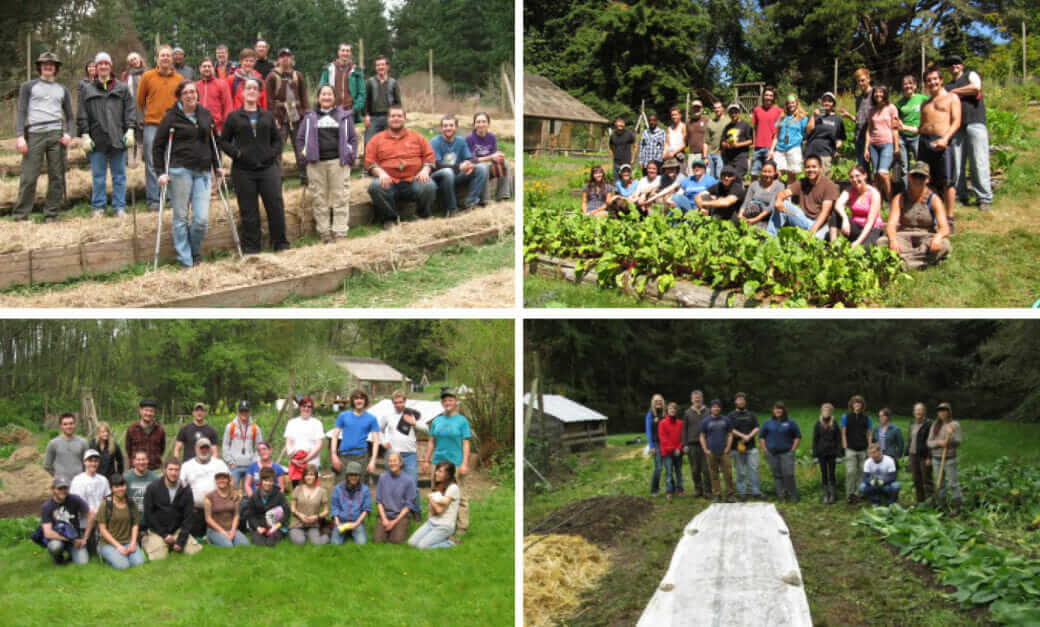
Whether you seek the meditative grace of the Labyrinth’s 11 concentric circles or the heady fertility of the Wetland Loop; rugged views on the Sky Loop or sweet birdsong in the Madrone Meadow; Chinook has a trail for you. We thank those whose tender loving care helped keep them all safe, open, and beautiful in 2013.
. . . . . . . . . . . . . . . . . . . . . . . . . . . . . . . . . . . . . . . . . . . . . . . . . . .
LABYRINTH CARE CIRCLE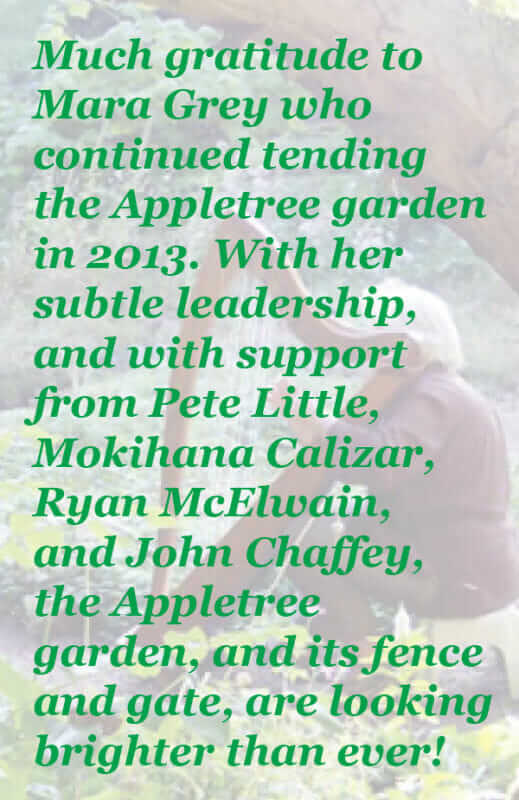
Anyone who has walked the Labyrinth at Chinook is familiar with the experience of “walking the path,” so symbolic of the human journey, the labyrinth’s course circling inward towards the center and out again, sometimes changing directions, until finally the seeker reaches their destination in the middle.
We are thankful for the volunteers that tend to this sacred space: weeding and maintaining the labyrinth, as well as caring for the many gifts left by many our visitors, pilgrims and sojourners at its center. We acknowledge Hannah Lee Jones, Carolyn Bolton, Beverly and Sarah Rose, and Mary Williams as well as John Chaffey and Detmar Straub for their labor of love.
. . . . . . . . . . . . . . . . . . . . . . . . . . . . . . . . . . . . . . . . . . . . . . . . . . .
WCLT’S TOURS AND WORKSHOPS
Our partnership with the Whidbey Camano Land Trust (WCLT) deepened in 2013, as Land Care Coordinator Maggie Mahle engaged with WCLT’s Land Steward, Jessica Larson, and Conservation Assistant, Ida Gianopulos, to better realize our conservation goals on Chinook’s 100 acres. Ida led two highly successful fungus tours on the land last fall, as well an invasive plant remediation workshop. The team at WCLT also assists in our annual land monitoring walk, provide key tools like maps and legal know-how, and collaborate on a range of other community offerings.
. . . . . . . . . . . . . . . . . . . . . . . . . . . . . . . . . . . . . . . . . . . . . . . . . . .
WETLAND LOOP INTERPRETIVE TRAIL IMPROVEMENTS
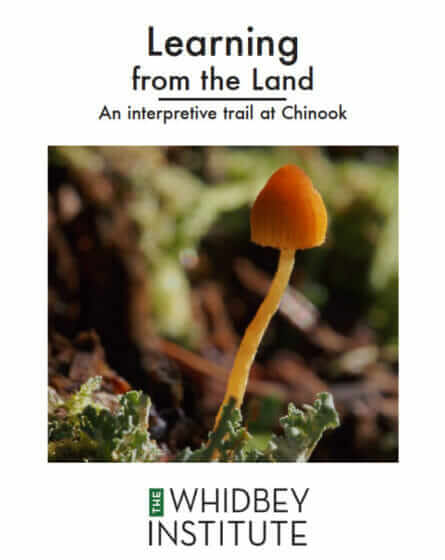
“The trees of the forest have secrets to tell.” Thus begins the 2003 Wetlands Interpretive Trail Guide. The guide has been revised and republished by the Whidbey Institute to inform and enhance your experience on the land. The trail was originally developed through a cooperative effort and was upgraded in 2013 with new interpretive sign posts. Each one is accompanied by an informative guidebook entry, inviting you to use your many senses, learn about the Chinook land, and gain a deeper understanding of wild places everywhere. Borrow a copy in the offices, or view it online!
. . . . . . . . . . . . . . . . . . . . . . . . . . . . . . . . . . . . . . . . . . . . . . . . . . .
TRAIL CLEARING
With miles of public trails weaving throughout the Chinook Lands, each season offers varying conditions and challenges. We rely on our community to assist in the maintenance of these paths for all to continue to enjoy. Maggie Mahle, Clayton Carlson, Detmar Straub, Tim Clark and Ben Thomas spent many days, in all weather making our trails accessible for public enjoyment. While a few fallen trunks have been left as gentle deterrents to vehicle traffic, all trails are now passable on foot and offer a world of wonder. We invite you to come explore them, too!
“When you ask people about what it is like being part of a great team, what is most striking is the meaningfulness of the experience. People talk about being part of something larger than themselves, of being connected, of being generative. It become quite clear that, for many, their experiences as part of truly great teams stand out as singular periods of life lived to the fullest. Some spend the rest of their lives looking for ways to recapture that spirit.” —Peter Senge, The Fifth Discipline
. . . . . . . . . . . . . . . . . . . . . . . . . . . . . . . . . . . . . . . . . . . . . . . . . . .
GROWING OUR TEAM
2013 was a year of honoring commitments at Chinook: our commitment to the Land that holds us, to the Programs the fulfill us, and to you, the friends with whom we share this Great Work. In addition to welcoming our talented interns, we grew our internal team by three.
Stewarding Chinook with Maggie Mahle
Last April, Maggie joined us from Denver, Colorado to take a new role as Land Care Coordinator. With Cary Peterson as her guide, she quickly became a pillar in our team and shared a holistic view of Chinook as a 100 acre ecosystem: caring for our wild and our tended spaces, while honoring our Forest Stewardship Plan and engaging deeply with our Site Committee and Facilities team. Last summer, as she settled in, Maggie said, “the land is always there, quietly offering its wisdom. Though our task as stewards may be to care for the land, the land has its own needs, and messages for us which only a deep listening can discern so that we can better focus our energy. The earth becomes an ally, and I’m reminded always how much our love and attention and care matters.”
Stoking Our Fire with Dan Mahle
Just weeks before Maggie joined our team, and through a separate hiring process, we welcomed another Mahle to our team: our energetic, deeply committed Program Assistant, Dan. (He happens to be Maggie’s son.) While he is primarily focused on design, coordination, outreach, and facilitation of our major annual programs, he is also deeply committed to the work of intergenerational collaboration, and involved in the Institute’s strategic planning.
“One of my greatest passions,” he said, “is to build a sense of belonging in the world—a sense of belonging to ourselves, belonging with each other, and belonging on Earth, and that’s what I get to work on every day! I love bringing people together to have deep conversations about what matters most.”
Telling Our Story with Marnie Jones
Marnie, our Communications Manager, joined our team in July. With a background in journalism, editing, and non-profit communications, she appreciates the power of words to inform, entertain, and inspire. She’s taken our blog to a new level with a series of Staff, Board, and Partner Spotlight articles. She also enjoys photography, and finds no shortage of beauty to capture at Chinook.
After attending her first Whidbey Island Bioneers conference in September, Marnie wrote, “Some things changed for me this weekend: my road looks steeper and more winding, but I feel I travel it with many friends. I now see my own personal causes as faces on one whole world in transition, and I see connections where I didn’t before. I am inspired to be better. To act more intentionally. To engage more fully. To live this life with courage, digging in.”
. . . . . . . . . . . . . . . . . . . . . . . . . . . . . . . . . . . . . . . . . . . . . . . . . . .
BOARD
As a non-profit educational 501(c)(3), we are fortunate for the leadership of our talented board of directors. Our board members demonstrate the courage, innovation, insight, and wisdom needed to guide us into our next chapter of achievement as an organization dedicated to the common good.
In 2013, we’ve had new members join the board from both Whidbey Island and the Seattle area, with diverse backgrounds in business, non-profit administration, education, finance, and development. They share a dedication to the Institute’s mission and, together, bring vitality and experience to our work.
President Gabriel Shirley, Vice President Kate Snider, Secretary Francis Janes, and board members Dorothy Baumgartner, Rick Paine, Gary Jusela, Dale Nienow, and Victoria Santos continue in service to the Institute. Please join us in extending a warm welcome to new board members Barbara Schaetti, Christie Lynk, Cole Hoover, Hilary Wilson, and Sheryl Harmer.
We would like to thank retired board member Allan Ament for his service. Allan, whose term ended last year, remains involved with the Institute in many ways and we are grateful for his all his contributions to the evolution of our organization, his continuing friendship and his ongoing engagement.
Below, our Fall Board retreat Held at the Storyhouse. From left to right: Rick Paine, Dorothy Baumgartner, Jerry Millhon, Allison Tongate, Gary Jusela, Francis Janes. Dale Nienow, Rick Paine, Dorothy Baumgartner.
. . . . . . . . . . . . . . . . . . . . . . . . . . . . . . . . . . . . . . . . . . . . . . . . . . .
SAYING GOODBYE
Thank You for the Memories
We wished our dear friend Mary Jakubiak a fond farewell in October. Mary served with love, attention, and prudence during her 22 years as resident caretaker of Chinook. Before her departure, we were grateful for an opportunity to celebrate with her and her sister Ginny at the home of Larry Daloz and Sharon Parks.
Mary was the “eyes and ears” of Chinook, through the seasons of the organization and the world around us, during her two decades here. A down-to-earth, thrifty and highly authentic soul, Mary is also admired for her beautiful photography of the land. Her photos continue to grace our publications and website.
Moving On, but Staying Close
As our former Facilities Manager, Clayton Carlson handled a variety of responsibilities large and small, cerebral and physical, grand and mundane. A vital part of our team for many years, Clayton brightened our days with his warm smile, can-do attitude, and anecdotes about his passion for Volkswagons.
Clayton left the Whidbey Institute at the end of 2013 to manage a crew at a well-established nearby business. His construction and facilities maintenance skills went with him, but a part of him stays here. “I’ve never felt like an employee here,” he said. “I’ve felt like a student. This is a place to learn.”
Writing Her Own Story
One of our beloved team members—Hannah Lee Jones— transitioned from her role as Communications Manager last June to dedicate all of her energy to the thing she loves most: her writing.
You know Hannah as the poetic voice whose deep connection to this place was clearly evident in our newsletters and other correspondence, and who had been a part of our greater community for over two years. We look forward to witnessing her journey as she blossoms into the ever more creative spirit and author she was born to be!
. . . . . . . . . . . . . . . . . . . . . . . . . . . . . . . . . . . . . . . . . . . . . . . . . . .
SPECIAL THANKS
We Thank Our 2013 Committee and Advisory Group Members for Their Service and Dedication
EXECUTIVE COMMITTEE: Gabriel Shirley, Kate Snider, Francis Janes, Jerry Millhon
Key Focus: The Executive Committee works on behalf of the Board, and represents the Board in actions deemed necessary during an emergency. It’s secondary purposes include providing: agendas in advance of each Board Meeting; mid-month check-ins on financials and other business, feedback in direction and trend discussions, brain trust on topics needing input.
GOVERNANCE COMMITTEE: Dorothy Baumgartner, Allan Ament
Key Focus: This Committee’s work focuses on the systems that support our Human Resources, like our charters, policies, and by-laws. A major project of 2013 was a comprehensive review and revision of our Organizational Policy Manual. This process updated obsolete or conflicting information, consolidated multiple historical documents, and infused our tomes with data that support our strategic direction.
FINANCE COMMITTEE: Wendy Fjelsted, Tom Buxton, Don Luby, Rick Paine, Jerry Millhon
Key Focus: This critical group oversees the nuts and bolts of our budgets, balance sheets and profit and loss reports. Each member brings a unique perspective from diverse professional backgrounds. Their work informs the direction of the Board, Staff and other Committees.
SITE COMMITTEE: Mira Steinbrecher, Tim Morley, Erik Erlandsen, Scott Mauk, Dylan Scoles, John Hastings, Jerry Millhon, Clayton Carlson, Allison Tongate, Maggie Mahle
Key Focus: The Site Committee ensures that all building projects, maintenance projects and practices, as well as land management projects and practices, conform to the Whidbey Institute’s Guiding Principles for the Chinook Lands, the Demonstration Building Principles & the most current Master Site Plan on file with Island County officials.
STRATEGY COMMITTEE: Heather Johnson, Kathleen Hosfeld, Sharon Daloz Parks, Larry Parks Daloz, Bill Koenig, Christie Lynk, Mark Yeoell, Geoff Bellman, Kate Snider, Gabriel Shirley, Sheryl Harmer, Cole Hoover, Gary Jusela, Jerry Millhon, Dan Mahle, and with special appreciation to Betsy Geist
Key Focus: To ensure that Whidbey Institute programs, activities and culture fulfill the strategic directions and mission of the organization, and that the Institute models interdependence between earth, spirit, and human future. In 2013, these deep thinkers created the foundation for all our current developments.
DEVELOPMENT COMMITTEE: Gabriel Shirley, Kate Snider, Francis Janes, Jerry Millhon, Allison Tongate
Key Focus: Approximately 50% of our activities rely on contributed income, and the Development Committee is responsible for stewarding the fundraising efforts of the organization to meet those needs. In 2013, the Committee worked to develop and refine internal systems to support donor relationships and cultivate meaningful engagements. This groundwork set the stage for the emergence of the Development Task Force and innovative and intentional strategies to unfold in 2014.
DEVELOPMENT TASK FORCE: Doug Kelly, Earl Lasher, Rick Paine, Mary Willis, Jean Singer, Tracy Robinson, Allison Tongate, and Jerry Millhon
Key Focus: This group is a think tank of wisdom keepers who deepen the context of our philanthropy work and enhance our ability to identify high leverage opportunities, assess needs and goals, and develop strategies that are actionable, doable, and practical.
. . . . . . . . . . . . . . . . . . . . . . . . . . . . . . . . . . . . . . . . . . . . . . . . . . .
THOMAS BERRY HALL
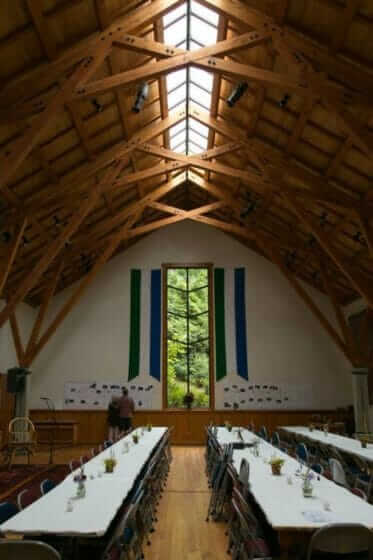
“Thomas Berry Hall has been an inspiring gathering place . . .
at the same time as it lifts to the sky and opens to the light, it draws people out to express their imagination and hope for our world.” —Ross Chapin Architects
As temperatures outside soared into the eighties last summer, Clayton Carlson and Jesse Durbin broke a serious sweat on a serious project: sanding and refinishing the hardwood floors in Thomas Berry Hall! The golden floor of old, scratched and worn from over 16 years of use (by everything from moving chairs into breakout circles to festive dancing), was finally refinished with Osmo polyx oil, an environmentally safe finish which is known to last. Asked how he was feeling, Clayton said, “I love doing this. I’ve been finishing floors since I was 16, and a new finish can really make a room sing.”
The entry, bathroom and dining floors were also refurbished to their original glory with the partnership of Clayton and Greg Gilles – who installed the floors when TBH was constructed. This type of integenerational collaboration has been a vital element to our acheivements in 2013 and beyond.
Other improvements included a hard-wiring of ethernet from our servers to the Hall. This may sound like a minor feat, but keep in mind: TBH was built before the internet was in use at Chinook! Having more bandwidth available in the Hall enabled our program leaders ability to better share their content with participants like YOU! In 2014, we continue to make strides to improve our users experience.
. . . . . . . . . . . . . . . . . . . . . . . . . . . . . . . . . . . . . . . . . . . . . . . . . . .
THE GREENHOUSE
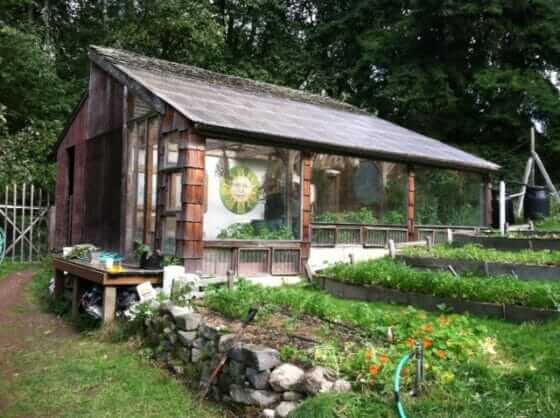 Our greenhouse, built in 1978 and partially restored a decade ago in an all-volunteer effort, is used daily for potting, tool and seed storage, propagation, potlucks, breakout sessions and light office work. Those who use it most were challenged by a leaking roof, and a wet, uneven floor. Last fall, we finally took decisive action to upgrade this multi-purpose structure back to a safe, dry workspace for the staff members, volunteers, and program participants who use it throughout the year. Maggie Mahle spearheaded the effort, supporting Clayton Carlson with roof repairs and coordinating the assistance of the students from Edmonds Community College’s Learn and Serve Environmental Anthropology Field (LEAF) School. Ben Thomas, Cary Peterson, Allison Tongate, Jerry Millhon, and Dan Mahle also helped with clean-up, leveling of the floors and a bucket brigade that moved gravel throughout the interior. The space is beautiful and functional once again! Whether through our weekly work parties or another occasion, we invite you to check it out for yourself this season.
Our greenhouse, built in 1978 and partially restored a decade ago in an all-volunteer effort, is used daily for potting, tool and seed storage, propagation, potlucks, breakout sessions and light office work. Those who use it most were challenged by a leaking roof, and a wet, uneven floor. Last fall, we finally took decisive action to upgrade this multi-purpose structure back to a safe, dry workspace for the staff members, volunteers, and program participants who use it throughout the year. Maggie Mahle spearheaded the effort, supporting Clayton Carlson with roof repairs and coordinating the assistance of the students from Edmonds Community College’s Learn and Serve Environmental Anthropology Field (LEAF) School. Ben Thomas, Cary Peterson, Allison Tongate, Jerry Millhon, and Dan Mahle also helped with clean-up, leveling of the floors and a bucket brigade that moved gravel throughout the interior. The space is beautiful and functional once again! Whether through our weekly work parties or another occasion, we invite you to check it out for yourself this season.
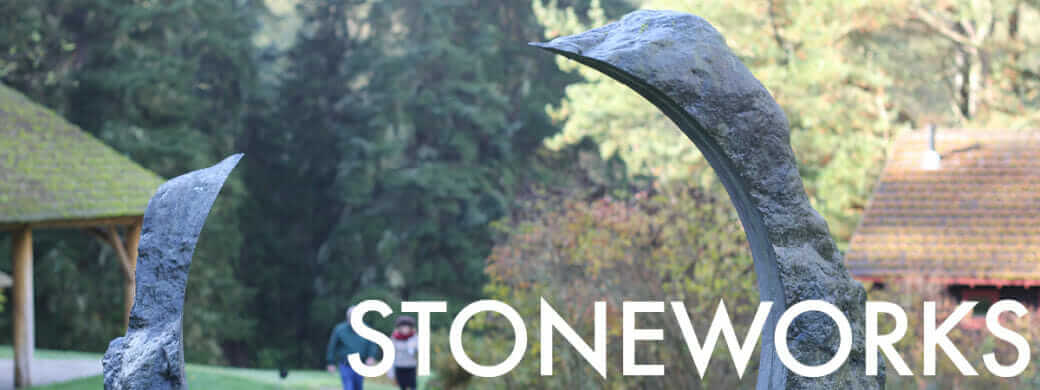
. . . . . . . . . . . . . . . . . . . . . . . . . . . . . . . . . . . . . . . . . . . . . . . . . . .
THE PATIO
The Farmhouse deck underwent a transformation last summer, in the first serious improvement since the Farmhouse was renovated in the late 90s. The replacement was designed for beauty, permanence, and safety. Deteriorating wood was replaced with beautiful, character-rich stone, while new wooden steps provide access to the deck and the back door at the Farmhouse.
In our 40th year, we saw in the deck a metaphor for the next 40. Beauty. Solidity. Simplicity. Sustainability. It is at the Farmhouse that the Chinook Learning Center started, and it was with a sense of grace that we launched into our next 40 from there, too.
The amazing people who took it from a rotting wood deck to a new stone patio deserve recognition. Clayton Carlson and support staff poured energy and skill into the demolition and perimeter work. Alexandra Morosco catalyzed, and Scott Hackney of Marenakos Rock Center donated, the beautiful quartz stone. Greg Gilles of Kamera Gilles provided key people who built walls, infilled sand, and laid stone. Kim Hoelting and Live Edge Woodworks provided the wood for the stairs and decking. All these skilled craftspeople made it happen in short time with wonderful results, and a beautiful dedication, keynoted by David Spangler, was held at our 40th Anniversary Festival.

. . . . . . . . . . . . . . . . . . . . . . . . . . . . . . . . . . . . . . . . . . . . . . . . . . .
THE PORTAL
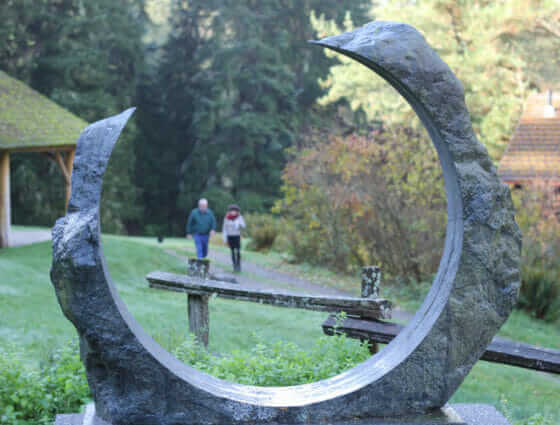 Our story in stone continued with the addition of the Portal to Thomas Berry Courtyard. In 2008, Bernie and Ellen Camin saw a compelling sculpture in artist Lloyd Whanell’s studio. Cut from the stone remains of another sculptor’s work, the piece—which they later named The Portal—spoke to them of serenity, reflection, and guidance. Ellen entered hospice care at home sometime thereafter, and took comfort from its enduring presence outside her window.
Our story in stone continued with the addition of the Portal to Thomas Berry Courtyard. In 2008, Bernie and Ellen Camin saw a compelling sculpture in artist Lloyd Whanell’s studio. Cut from the stone remains of another sculptor’s work, the piece—which they later named The Portal—spoke to them of serenity, reflection, and guidance. Ellen entered hospice care at home sometime thereafter, and took comfort from its enduring presence outside her window.
“With her departure and mine to come,” Bernie writes, “the Portal needed a new home. I never felt that I owned it, only that I was a steward for it.” Bernie selected the Whidbey Institute as the Portal’s next steward, donating the sculpture in recognition of the impact Chinook has made on his life, on Ellen’s, and on so many others.
. . . . . . . . . . . . . . . . . . . . . . . . . . . . . . . . . . . . . . . . . . . . . . . . . . .
A TALE OF TWO PINES
Many of you will remember the two massive white pines which, until recently, stood beside the historic Farmhouse at Chinook. They were our friends, our neighbors, and our guardian trees. They lived for over a century, and they were loved. In recent decades, blight crept in. Sap bled. Limbs creaked. Around the time of their 120th winter solstice, for reasons of safety and to the sound of prayers and chainsaws, the two white pines were felled.
We undertook this endeavor with great reverence and care, and invited all who felt moved to join us before the felling for an Honoring Ceremony held in December. To those who showed their love for our two sick white pine trees, thank you. When David Spangler told our Ceremony host Marilyn Strong about his intuitive sense of the trees, he expressed that they were quite ready to move on. “The trees are giving up their form,” he said, “but they continue in their life.” David added this: “It is said that when we carry wood into our lives, we carry a piece of the primal forest as well—something of which we are all a part.”
We would like to acknowledge the neighbors and professionals whose sensitivity and skill contributed to the safe, respectful, and efficient felling of these two noble giants. We would especially like to thank Kim Hoelting, Rob Robinson, Terry Bourke, Robert Long, Dave Anderson, Marilyn Strong, Becker, Toby, and our own Jerry Millhon, Maggie Mahle, Clayton Carlson, and Alexa MacAulay for their veneration, ingenuity, and tireless effort during the preparation, tree removal, and cleanup.
From death comes rebirth, and so it goes with the white pines. In conjunction with the Whidbey Island Woodworkers’ Guild, we’ve launched a new Thriving Communities project to infuse the spirit and material bounty of the white pines—which yielded seven tons of millable timber—into our economy and culture. We look forward to sharing the progress of this community collaboration throughout 2014.
. . . . . . . . . . . . . . . . . . . . . . . . . . . . . . . . . . . . . . . . . . . . . . . . . . .
LIGHTNING STRIKES!
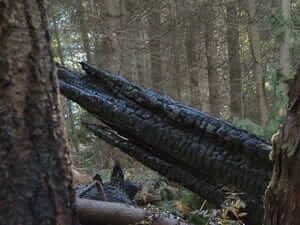 We were witness to nature’s mighty power when one of our oldest and tallest fir trees was struck by lightning last September. The lightning strike, in felling the massive tree, revealed the awesome strength of the elements. The experience gave us a chance to appreciate our fellow trail users, one of whom discovered the resulting fire during a hike, and our local firefighters, whose competence in reaching the steep, off-trail site and putting out the smouldering embers helped limit the damage to a 40-ft. diameter burn.
We were witness to nature’s mighty power when one of our oldest and tallest fir trees was struck by lightning last September. The lightning strike, in felling the massive tree, revealed the awesome strength of the elements. The experience gave us a chance to appreciate our fellow trail users, one of whom discovered the resulting fire during a hike, and our local firefighters, whose competence in reaching the steep, off-trail site and putting out the smouldering embers helped limit the damage to a 40-ft. diameter burn.
. . . . . . . . . . . . . . . . . . . . . . . . . . . . . . . . . . . . . . . . . . . . . . . . . . .
OUR FORESTRY PRACTICES
“The product coming out of the woods must take second place. The welfare of the forest must come first.” —Merve Williamson
In Anne Linnea’s book, Keeper’s of the Trees, she mentions Merve Wilkinson, who came to the Whidbey Institute in 2001. Merve has managed his Wildwood Farm in British Columbia for decades and his story is one worth reading. A gentle giant!
He comes to mind as we share our activities in selectively logging trees around the Chinook Land. Some had reached the end of their life span. Some needed to be thinned for forest health. Some were dead and could have fallen on the Sanctuary or other nearby buildings. Several black locusts near the art barn was felled last summer, for instance, after shedding limbs and becoming brittle.
As part of our Site Committee’s promise to manage resources responsibly, the lumber from Chinook trees is milled for future building projects, used as fence poles, or split for our firewood supply. Some is turned into gorgeous bowls by local woodworker Terry Bourke.
“We do not need to plan or devise a ‘world of the future’;
if we take care of the world of the present, the future will have received full justice from us.”—Wendell Berry
. . . . . . . . . . . . . . . . . . . . . . . . . . . . . . . . . . . . . . . . . . . . . . . . . . .
SUSTAINABLE CONNECTIONS ENERGY AUDIT
As part of our work to grow our sustainability efforts, we partnered with Sustainable Connections’ Community Energy Challenge program to improve our energy efficiency at the Institute. Working with professionals provided by Sustainable Connections, the Institute underwent a full energy audit, and subsequent walkthrough to choose viable measures to implement. The audit uncovered room for improvement in areas ranging from our Thomas Berry Hall boiler system to the sealant we use around our windows. We received a personalized action plan to begin taking steps to improve the quality of our energy use and to save natural resources and money.
We took next steps, with the help of Bryant of Bartlett Electric, by installing over 20 new LED lights throughout TBH and the WI offices. LED bulbs provide energy savings by using up to 80% less energy to produce the same amount of brightness as that of CFLs and incandescent bulbs; have an exceptionally long lifespan (a LED light can last about 17 years before it needs changing!); have no filament or moving parts, making them durable and low maintenance; and generate almost no heat or UV rays. Additionally, through this program, we were able to access utility and tax rebates that further increase our return on investment.
We continue to integrate our action plan within our facility improvements and are so grateful to the good work of Sutainable Connections for providing this service to our organization, and for your ongoing monitoring and support!
. . . . . . . . . . . . . . . . . . . . . . . . . . . . . . . . . . . . . . . . . . . . . . . . . . .
OUR HOME ON THE WEB
Our website underwent a major transformation in 2013, with a complete overhaul to better serve the needs of our growing audience. In addition to an aesthetic revitalization, our new home on the web has been enriched by enhanced, more current information. The upgrades include:
- A blog full of partner interviews, staff and board profiles, and stories from the land
- This is a timely and informative way to learn more about the people who bring their work to the Institute and the types of work we engage. Tune in to our blog and stay current on staff and board projects and successes, and remain connected with the land you love.
- A more complete and accessible events listing
- With enhanced features like advanced filtering, calendar linking, multi-media capacity, “Learn More Here” is on a whole new level!
- Fun extra content, like new videos, Plant of the Month profiles, and more!
The maturation of our online home, both on our website and on social media serves many purposes: it preserves our natural resources by allowing us to become more paper-free, it allows us to communicate effectively and efficiently, it allows for different types of content to be shared (video, for example), and it nurtures the connections which are at the core of all we do. We thank Allison Tongate, Jacob Dubail, and the Team at Pyramid Communications for bringing this beautiful website into the world!
. . . . . . . . . . . . . . . . . . . . . . . . . . . . . . . . . . . . . . . . . . . . . . . . . . .
2013 FINANCIALS
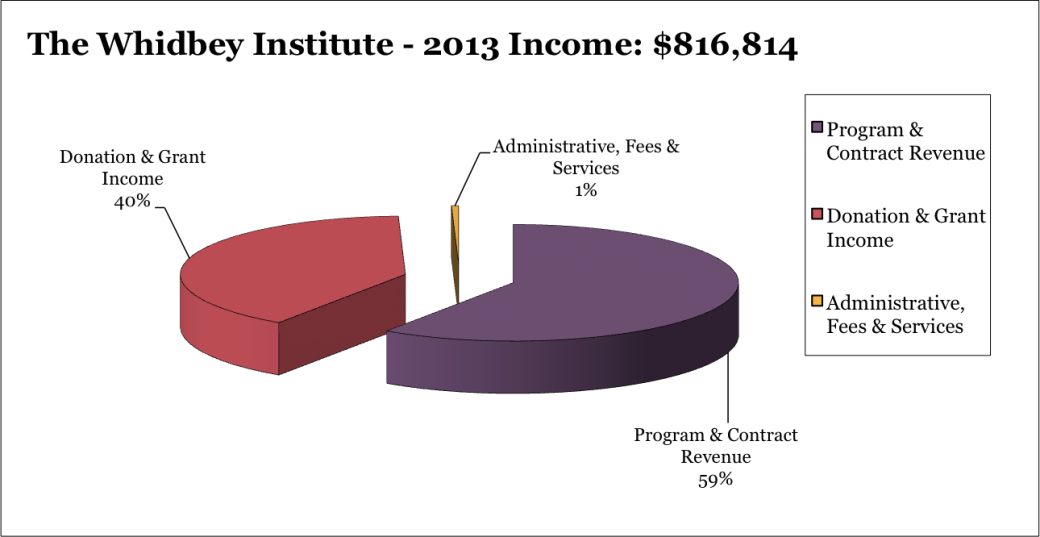
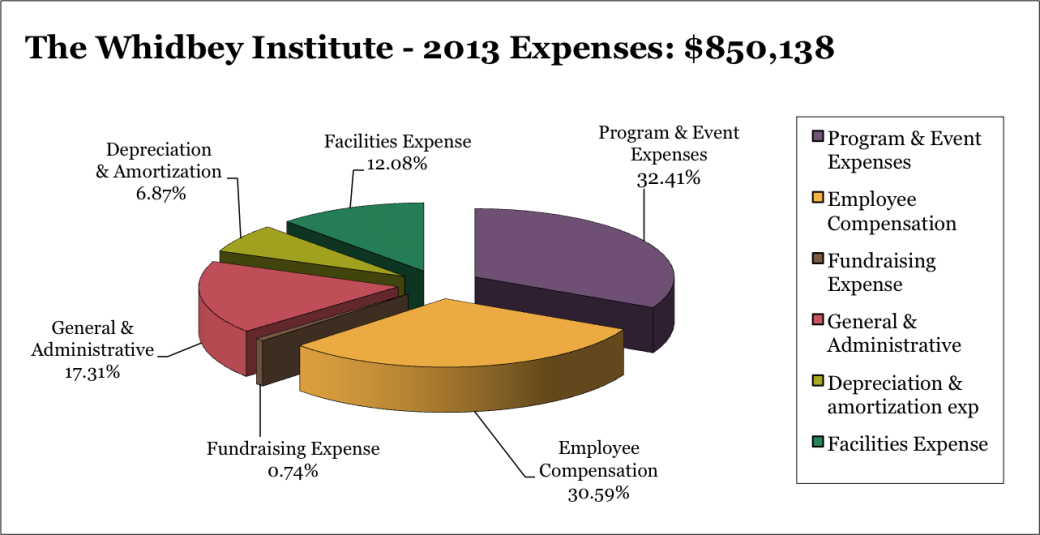
. . . . . . . . . . . . . . . . . . . . . . . . . . . . . . . . . . . . . . . . . . . . . . . . . . .
THANK YOU
FOR ALL YOU DO TO MAKE THIS WORK POSSIBLE.
WITH DEEP GRATITUDE – THE BOARD & STAFF OF THE WHIDBEY INSTITUTE
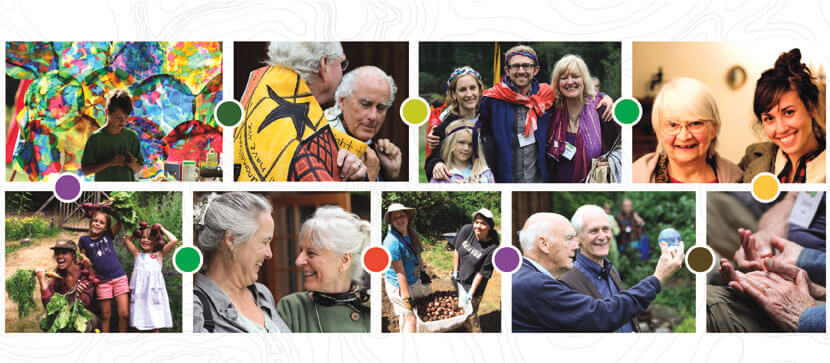
. . . . . . . . . . . . . . . . . . . . . . . . . . . . . . . . . . . . . . . . . . . . . . . . . . .
